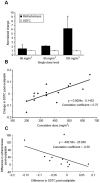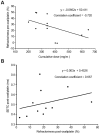Dose effects of oxaliplatin on persistent and transient Na+ conductances and the development of neurotoxicity
- PMID: 21494615
- PMCID: PMC3072981
- DOI: 10.1371/journal.pone.0018469
Dose effects of oxaliplatin on persistent and transient Na+ conductances and the development of neurotoxicity
Abstract
Background: Oxaliplatin, a platinum-based chemotherapy utilised in the treatment of colorectal cancer, produces two forms of neurotoxicity--acute sensorimotor neuropathic symptoms and a dose-limiting chronic sensory neuropathy. Given that a Na(+) channelopathy has been proposed as the mechanism underlying acute oxaliplatin-induced neuropathy, the present study aimed to determine specific mechanisms of Na(+) channel dysfunction.
Methodology/principal findings: Specifically the function of transient and persistent Na(+) currents were followed during treatment and were investigated in relation to oxaliplatin dose level. Eighteen patients were assessed before and after a single oxaliplatin infusion with motor and sensory axonal excitability studies performed on the median nerve at the wrist. While refractoriness (associated with Na(+) channel inactivation) was significantly altered post-oxaliplatin infusion in both motor (Pre: 31.7±6.4%; Post: 68.8±14.5%; P≤.001) and sensory axons (Pre: 31.4±5.4%; Post: 21.4±5.5%; P<.05), strength-duration time constant (marker of persistent Na(+) conductances) was not significantly altered post-infusion (Motor Pre: 0.395±0.01 ms; Post: 0.394±0.02 ms; NS; Sensory Pre:0.544±0.03 ms; Post: 0.535±0.05 ms; NS). However, changes in strength-duration time constant were significantly correlated with changes in refractoriness in motor and sensory axons (Motor correlation coefficient = -.65; P<.05; Sensory correlation coefficient = .67; P<.05).
Conclusions/significance: It is concluded that the predominant effect of acute oxaliplatin exposure in human motor and sensory axons is mediated through changes in transient rather than persistent Na(+) conductances. These findings are likely to have implications for the design and trial of neuroprotective strategies.
Conflict of interest statement
Figures




References
-
- Raymond E, Faivre S, Woynarowski JM, Chaney SG. Oxaliplatin: Mechanism of action and antineoplastic activity. Semin Oncol. 1998;25(2 Suppl 5):4–12. - PubMed
-
- de Gramont A, Figer A, Seymour M, Homerin M, Hmissi A, et al. Leucovorin and Fluorouracil with or without Oxaliplatin as first-line treatment in advanced colorectal cancer. J Clin Oncol. 2000;18:2938–2947. - PubMed
-
- André T, Boni C, Mounedji-Boudiaf L, Navarro M, Tabernero J, et al. Oxaliplatin, Fluorouracil, and Leucovorin as adjuvant treatment for colon cancer. N Engl J Med. 2004;350:2343–2351. - PubMed
-
- Gamelin E, Gamelin L, Bossi L, Quasthoff S. Clinical aspects and molecular basis of oxaliplatin neurotoxicity: Current management and development of preventive measures. Semin Oncol. 2002;29(5 Suppl 15):21–33. - PubMed
-
- Lehky TJ, Leonard GD, Wilson RH, Grem JL, Floeter MK. Oxaliplatin-induced neurotoxicity: Acute hyperexcitability and chronic neuropathy. Muscle Nerve. 2004;29:387–392. - PubMed
Publication types
MeSH terms
Substances
LinkOut - more resources
Full Text Sources
Miscellaneous

